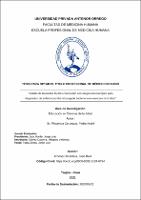Validez de leucocitos fecales comparado con sangre macroscópica para diagnóstico de enfermedad diarreica aguda bacteriana en menores de 5 años

View/
Download
(application/pdf: 850.9Kb)
(application/pdf: 850.9Kb)
Date
2022Author(s)
Plasencia Coronado, Pedro André
Metadata
Show full item recordAbstract
Establecer la validez diagnóstica del Examen de Leucocitos fecales y
la Observación de Sangre macroscópica comparada con el Coprocultivo en la
Enfermedad Diarreica Aguda bacteriana de pacientes menores de 5 años
atendidos en el Servicio de Emergencias Pediátricas del Hospital Belén de
Trujillo durante Septiembre del 2019 a Febrero del 2020.
MATERIAL Y MÉTODO: Es una investigación tipo Pruebas Diagnósticas,
observacional analítico donde se evaluaron 102 pacientes con EDA menores de
5 años, de ambos sexos,atendidos en el Servicio de Emergencias Pediátricas del
Hospital Belén de Trujillo durante Septiembre del 2019 al Febrero del 2020 que
cumplieron con los criterios deselección recolectando los resultados en la hoja
de recolección de datos para luego ser evaluado el rendimiento diagnóstico a
través de Sensibilidad (S), Especificidad (E), Valor Predictivo Positivo (VPP),
Valor Predictivo Negativo (VPN) y Valor Diagnóstico (VD).
RESULTADOS: Realizados 102 exámenes de Leucocitos Fecales (LF) se
obtiene como mejor punto de corte para diagnóstico el valor de 60. Comparados
el rendimiento diagnóstico de LF versus Observación Macroscópica de sangre
en heces se determina que LF es más efectiva en el diagnóstico de EDA
bacteriana (S:53.19% , E:85.45%, VPP:75.76%, VPN:68.12%, VD: 70.59%).
CONCLUSIÓN: El uso de Leucocitos Fecales tomando como punto de corte el
valor 60 es mejor indicador diagnóstico que el punto 50 para EDA bacteriana
además el punto 60 es más útil frente a la Observación Macroscópica de sangre
en heces. La observación macroscópica de sangre en heces no puede
considerarse certera para concluir que la EDA sea de origen bacteriano. El
agente etiológico más frecuente de EDA bacteriana es Escherichia coli. To establish the diagnostic validity of the Fecal Leukocyte
Examination and the Macroscopic Blood Observation compared with the
Coproculture in the Acute Bacterial Diarrheal Disease of patients under 5 years
of age treated in the Pediatric Emergency Service of the Hospital Belén de Trujillo
during September 2019 a February 2020.
MATERIAL AND METHOD: It is an analytical observational Diagnostic Test type
investigation where 102 patients with ADD under 5 years of age, of both sexes,
treated at the Pediatric Emergency Service of the Belén Hospital in Trujillo during
September 2019 to February 2020 were evaluated. met the selection criteria by
collecting the results in the data collection sheet to later evaluate the diagnostic
performance through Sensitivity (S), Specificity (E), Positive Predictive Value
(PPV), Negative Predictive Value (NPV) and Diagnostic Value (VD).
RESULTS: Performed 102 tests of Fecal Leukocytes (FL), the best cut-off point
for diagnosis is 60. Comparing the diagnostic performance of LF versus
Macroscopic Observation of blood in feces, it is determined that LF is more
effective in the diagnosis of EDA bacterial (S: 53.19%, E: 85.45%, PPV: 75.76%,
NPV: 68.12%, DV: 70.59%).
CONCLUSION: The use of Fecal Leukocytes, taking the value 60 as the cut-off
point, is a better diagnostic indicator than point 50 for bacterial EDA, in addition,
point 60 is more useful compared to the Macroscopic Observation of blood in
feces. The macroscopic observation of blood in Stool cannot be considered
accurate to conclude that EDA is of bacterial origin. The most frequent etiological
agent of bacterial EDA is Escherichia coli.
Collections
- Medicina Humana [2969]

